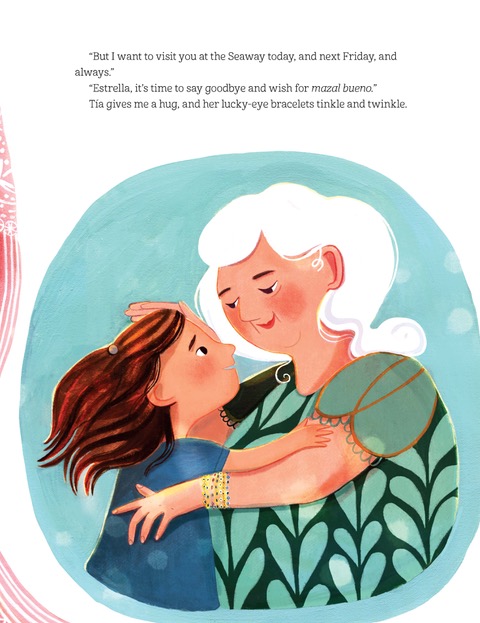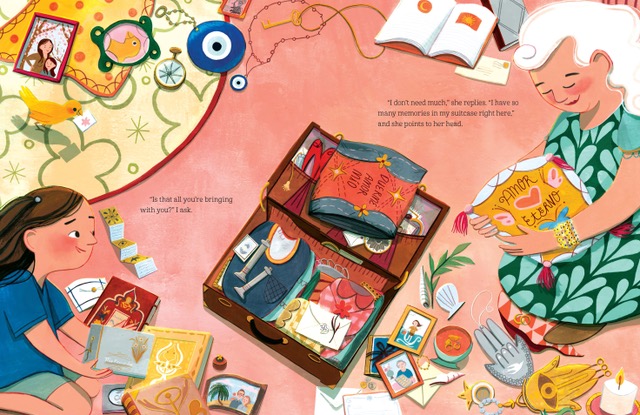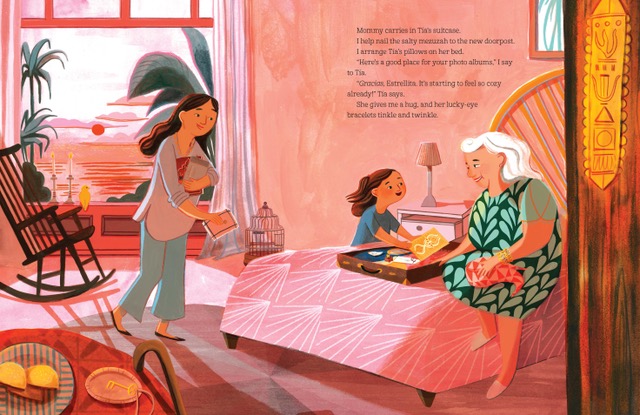
When I began writing my first picture book, Tía Fortuna’s New Home, I wanted to honor my Sephardi heritage by focusing on two characters, an auntie named Tía Fortuna, and her young niece, Estrella. I imagined them spending one ordinary and yet momentous day together in Miami as Tía Fortuna packs up her things and they say goodbye together to her humble pink casita on the beach, which is about to be demolished to build a luxury hotel. Estrella is there to assist her auntie and to accompany her to her new home, an assisted living residence that is far from the sea but is surrounded by banyan trees and butterflies.
Nowhere do I announce that they are Sephardi or even Jewish. It is through the visual elements that we learn about their heritage. The art is therefore a crucial part of the book, and I was fortunate that the talented artist Devon Holzwarth agreed to be the illustrator for this story. She makes the loving relationship between Estrella and Tía Fortuna come alive. Through their caring gazes toward each other, we see and feel how their intergenerational bond nurtures both of them. The symbols of Sephardi culture are represented with hamsas, evil eye ornaments, a mezuzah, family photos, and keys from homes in Havana and Miami, as well as Tía Fortuna’s lucky eye bracelets. The Miami setting is conjured in lush detail with representations of Cuba and other lost homes woven in.

Devon captures the flow of time beautifully, from the luminous sunshine on the beach in the morning, to the orange-pink glow of sunset, with Shabbat candles lit on the windowsill, and then the stars shining in the evening sky when Estrella says goodbye to Tía Fortuna. Devon was open to pictorial suggestions, so I sent her images of The Seaway, the demolished building that inspired the setting for the story. I sent her photos of my embroidered pillows that say “Duerme amor mío” and “Amor eterno,” which she generously incorporated into the art. I made sure she knew what my lucky eye bracelets look like and asked that Tía Fortuna be shown wearing not one but several of them. And Devon brought her own magical vision to the story, introducing a little yellow bird who is going on the journey with Tía Fortuna. Kids love spotting the bird on each of the pages, a detail which keeps them immersed in reading the book.
One very important symbol in the book is the suitcase, representing the diasporic history of the Jewish people. We see it most notably on a page where Estrella asks her auntie what she’s bringing with her, and Tía Fortuna says she doesn’t need much. “I have so many memories in my suitcase right here,” and she points to her head. One lovely touch is that when you remove the book jacket, you discover that the book cover itself is a suitcase. The story is carried within the suitcase that has a little tag hanging from the handle that says “Tía Fortuna.”
Sephardi heritage can seem too melancholy sometimes. I wanted to give children a less sorrowful image of our heritage, so they can see the Sephardim as joyful and poetic and open to new experiences, enjoying and also sharing their delicious borekas with others, and filled with esperanza for lots of mazal bueno, and, perhaps most important, treating each day as a blessing.


Tía Fortuna’s New Home: A Jewish Cuban Journey, written by Ruth Behar and illustrated by Devon Holzwarth, New York: Knopf, 2022.
The English and Spanish edition, El nuevo hogar de Tía Fortuna: Una historia judía-cubana (Traducido por Yanitzia Canetti), are available for order and as audiobooks at penguinrandomhouse.com.


